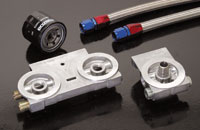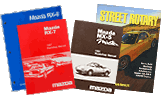Oil Filters & Metering Oil Pump

The installation of a remote oil filter mount eases engine installation and removal.
Oil Filters
For most engine applications we recommend the use of the stock Mazda oil filters (or comparable aftermarket version) for all applications other than serious race cars. With the stock filter the only undesirable feature is the internal pressure bypass feature that is incorporated into the filter design. The internal bypass valve within the filter is designed to open if the filter becomes clogged or the oil is too thick. When the preset pressure is exceeded the bypass value opens and allows the oil to bypass the filter element and pass directly through the center tube back into the engine. During engine warm-up, if the engine is cold and the RPM is high, the pressure differential might exceed 14 PSI, causing the filter to bypass some contaminants that might be damaging to the engine bearings. To avoid this, always warm up the engine gradually and fully before running at high RPM.
Remote Mount Oil Filters
For serious racing applications, remote, non-bypass filters perform better than stock filters/mounts. We recommend installing a remote, double oil filter assembly on the return line from the oil cooler.
The remote filter mounts we offer allow the installation of temperature and pressure senders away from the engine block, thereby simplifying engine installation and removal. Use of the FRAM HP-2 model non-bypass filters will provide both excellent filter capacity and elimination of the bypass. One other filter possibility is the FRAM HP-6. It is larger in diameter the HP-2, but only one filter is necessary, thus making it easier to mount. The only limitation to this filter is that it has an internal pressure bypass set for 22 PSI. However, this is high enough that bypass is unlikely to occur in reasonable use.
Rotaries can also be run with a dry sump oil system; that is, an oil system that pumps the oil out of the bottom of the engine into an external tank, then picks it up from the tank and supplies it to the engine. The primary reason for doing this is to gain clearance under the engine, or to allow the engine to be lowered (the pan is commonly replaced with a flat plate). If the tank is well designed, this system also aids oil cooling by removing the air from the oil before cooling.
Metering Oil Pump
The metering oil pump is a useful but misunderstood component of a rotary engine. These units have proven to be reliable over the years, although people commonly try to blame the metering oil pump for high oil consumption. In fact, if the pump fails, it usually simply stops operating. In 1998 and earlier engine applications, the only likely exception would be if the linkage from the carburetor, or injection throttle body, becomes hung up in the "full throttle" position.
This condition is quite easy to diagnose. If the problem is not in the linkage, the rotor oil seals are the most likely source of trouble. As a general note, later model rotaries commonly get 2,000+ miles per quart of oil. If oil consumption exceeds one quart in 700 miles, the engine probably needs an overhaul. The factory recommended setting for the metered oil volume has generally been getting lower and lower.
Metering Oil Pump Rates
The metering rates for stock engines vary, so consult an appropriate shop manual for your car’s specifications. In normally aspirated racing vehicles we use either a setting of 5ml/5minutes (total flow - 2,000 RPM, warm engine, arm in the "full throttle" position) on the metering oil pump or premix 3.5 oz (103ml) of good quality synthetic oil (preferably 2-stroke motorcycle "oil injection" oil) to 5 gallons of fuel. The requirement for turbo engines in racing is high enough that use of a metering oil pump is impractical. Therefore, we premix up to 22 oz (650ml) of oil to 5 gallons of fuel in a 600 HP 2-rotor. If you are not pressing your engine this hard, you can use proportionally less oil.
The metering oil pump found on all 1989-95 RX-7s is an electronic unit that cannot be externally adjusted to change oil flow delivery; however, if you require additional oil flow, you can completely remove this electronic unit and fabricate a cover plate with an adjustment screw mounted in it to allow manual adjustment of the oil flow. This cover plate replaces the electronic control.
RX-8 - Race Tips
While undertaking development work on the RX-8 Renesis engine for SCCA T2/T3 use, we decided to introduce extra oil into the fuel to monitor the effect. To our surprise, this additional oil increased power! Further dyno testing found that by adding 10 oz. of Royal Purple 2-Stroke Oil to 6 gallons of fuel, we gained an average of 1.7 HP from 2000-9000 RPM, along with an increase in peak power of 4 HP. We validated this increase by changing back to a "non-oiled" fuel - and the power returned to the previous level. Later, we tried the same test with another brand of synthetic oil with nearly the same results.
For racing applications, the addition of a high quality synthetic oil increases power and most certainly decreases wear. The only negatives are the cost of the oil and an increase in the tendency to foul the spark plugs. (Note: We have not performed these tests on non-RX-8 engines yet, these results are unknown.)
Oil Hose Sets
Since the inception of Racing Beat back in the early 1970’s we’ve been strong advocates for the use of a high quality braided oil lines for use on both street and performance applications. Stock oil lines will age, swell and potentially leak over time. A failed oil line could be catastrophic on a rotary engine since oil pressure and temperature are critical to engine longevity. When installing replacement oil hoses take care to prevent each hose from contacting adjacent chassis components in order to prevent wear to the braided material. If needed, install anti-chaffing material around the hose to prevent premature wear.
If you attempt to assemble your own oil line sets using commonly available -10 components, you soon find that standard adaptor fittings cannot be used on the oil coolers or engine connections as these fittings are metric. To remedy this issue we offer both 16mm and 18mm adaptor fittings that accept -10 hose fittings.
Copyright 2007-2024 Racing Beat, Inc ©






